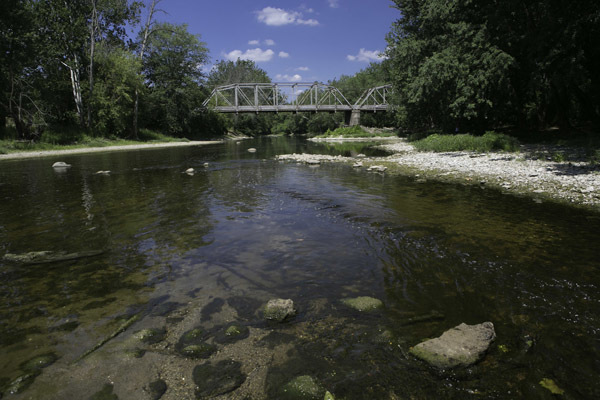By John Shuey, director of science, The Nature Conservancy in Indiana
The “dead zone” in the Gulf of Mexico remains a major environmental issue – particularly for those who depend upon the Gulf for their livelihoods.
The “dead zone” disrupts the Gulf’s valuable fishery, threatening both commercial and recreational fisheries valued at almost $1 billion.
The cause of the dead zone is nitrogen pollution, which has created an oxygen-free area, now the size of the state of Connecticut.
Indiana has been identified as one of the states contributing the most excess nitrogen to the Gulf of Mexico, and these nutrients come from a variety of sources, both urban and rural.
A new study by the University of Notre Dame is showing that restored floodplain forests along the Wabash River in Indiana can help decrease the amount of nitrogen reaching the Gulf.
The study, developed by a team of freshwater ecologists at the University of Notre Dame, highlights the pivotal role that the Wabash River can play in reducing the dead zone. It also demonstrates how restored floodplain forests are a remarkable investment for improving water quality.
The study was underwritten by The Nature Conservancy and funded by the Walton Family Foundation, as part of their support for the Conservancy’s work on the Wabash River.
Although the Wabash River represents just about 3% of the total Mississippi River Basin area, it delivers a whopping 11% of the nitrogen that flows into the Gulf.
The Conservancy’s work with the Natural Resources Conservation Service (NRCS), Soil and Water Conservation Districts, farmers and landowners along the Wabash River, however, is proving to be a big part of the solution.

Wabash River. Photo: © Cristina Rutter
“The report shows that for a comparatively small investment, Indiana can have a big impact on water quality both in the state and down river,” says Professor Jennifer Tank at the University of Notre Dame. “Taxpayers, landowners, conservationists and resource managers should all be thrilled to see so much bang for the buck.”
The restored floodplain forests along the Wabash River are generating a remarkable return on investment for water quality, making Indiana one of the best places to invest in restoration efforts. The Notre Dame findings estimate that nearly 600 pounds of nitrogen are cleaned out of the river annually by every acre of floodplain that is restored.
“The Natural Resources Conservation Service (NRCS) has been restoring floodplains along the Wabash River since 1973,” said Jane Hardisty, State Conservationist at Indiana USDA-NRCS. “Nearly 30,000 acres of previously farmed floodplain has been restored to natural habitats and forest, and we’re seeing a great impact.”
In addition, the restored floodplain forests create new habitats for Indiana’s wildlife along the river. More importantly, these restored floodplains are cleaning the river during floods. As floodwaters enter the restored floodplain habitats, the currents slow down, allowing pollutants to settle out and be filtered and processed by plants and animals. The restored habitats, which represent just 0.3% of the lands drained by the Wabash, could be removing 7% of the nitrogen in the river.
Just as importantly, the floodplains also remove phosphorus (another nutrient that pollutes water) and sediment from the river as well.
While these pollutants don’t threaten the Gulf as much as nitrogen, they still contribute to impaired water quality in the Wabash and the Ohio River. The restored acres could reduce sediments and phosphorus by 3% annually.
According to the study, Indiana has the potential to reduce the flow of pollutants to the Gulf even further by restoring even more floodplain.
“By restoring an additional 55,000 acres of floodplain along the Wabash, which is less than 1% of the river’s entire watershed, we could reduce the amount of nitrogen leaving the state by 20%,” said Mary McConnell, state director for the Conservancy’s Indiana Chapter. “This is a reduction of 1,100 truckloads of nitrogen delivered to the Gulf of Mexico each year!”
